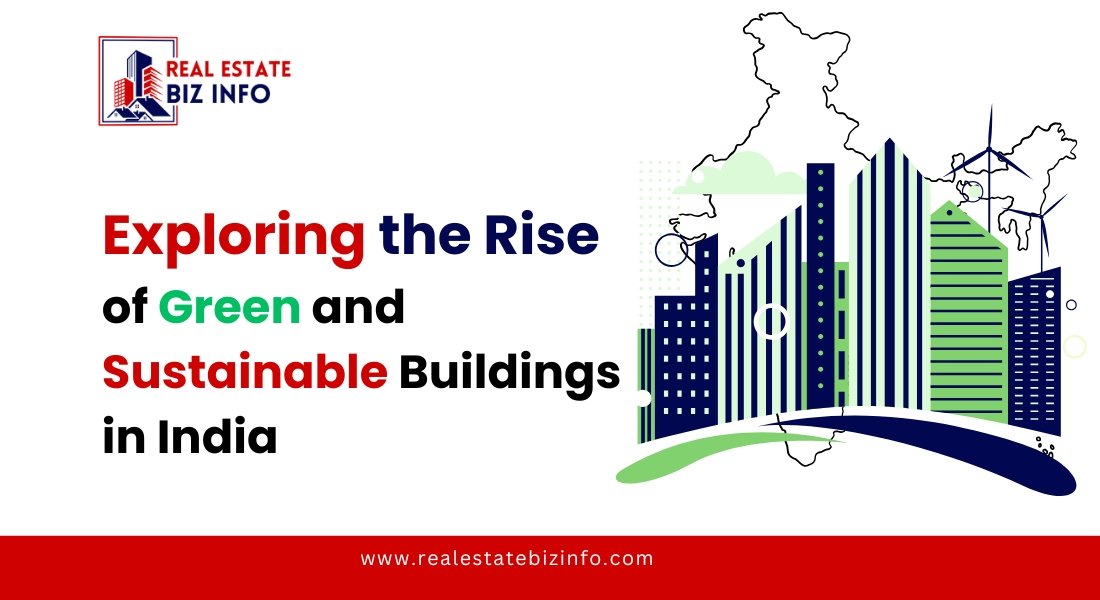As environmental concerns gain prominence globally, India is emerging as a key player in the adoption of green and sustainable building practices. From residential complexes to commercial spaces, the demand for environmentally friendly construction is growing rapidly, driven by awareness, government incentives, and the economic benefits of sustainability. In this detailed exploration, Real Estate Biz Info dives into the rise of green buildings in India, the driving forces behind this trend, and its implications for the real estate sector.
What are Green and Sustainable Buildings?
Green and sustainable buildings are designed to minimize environmental impact and improve resource efficiency throughout their lifecycle. These structures focus on:
- Energy Efficiency: Using renewable energy sources and reducing overall energy consumption.
- Water Conservation: Incorporating rainwater harvesting, wastewater recycling, and low-flow fixtures.
- Material Sustainability: Utilizing eco-friendly, recycled, or locally sourced materials.
- Indoor Air Quality: Ensuring proper ventilation and using non-toxic materials.
Such buildings not only benefit the environment but also offer enhanced comfort and reduced operational costs for occupants.
The Growing Need for Green Buildings in India
India’s rapid urbanization and population growth have put immense pressure on its resources. The construction industry alone accounts for a significant share of the country’s energy consumption and carbon emissions. Green buildings offer a sustainable solution to:
- Mitigate climate change.
- Address water scarcity.
- Reduce energy dependency.
- Enhance urban livability.
The rise of green buildings is essential to ensure that India’s growth trajectory aligns with its environmental goals.
Government Policies and Incentives
The Indian government has introduced several initiatives to promote green and sustainable construction.
Green Rating for Integrated Habitat Assessment (GRIHA): A national rating system encouraging sustainable construction practices.
Indian Green Building Council (IGBC): Certifies buildings based on their environmental performance.
Faster Approvals: Green projects often receive expedited approvals from municipal bodies.
Tax Incentives: Developers and homeowners of certified green buildings benefit from reduced property taxes and other financial incentives.
Energy Conservation Building Code (ECBC): Mandates energy efficiency standards for new commercial buildings.
Technological Innovations in Green Building
Technology plays a pivotal role in driving sustainable construction practices.
Smart Building Systems:
- IoT-enabled devices for energy and water management.
- Automated lighting and HVAC systems to optimize resource use.
Renewable Energy Integration:
- Rooftop solar panels.
- Wind energy for power generation.
Advanced Materials:
- Use of low-emission paints and recycled steel.
- Insulating materials to reduce cooling and heating needs.
Digital Twin Technology:
- Simulations to optimize building performance and resource usage before construction.
Economic Benefits of Green Buildings
Contrary to the perception that green buildings are expensive, they offer long-term financial benefits.
Lower Operational Costs:
- Reduced energy and water bills.
- Minimal maintenance costs due to durable materials.
Higher Property Value:
- Green-certified buildings command premium pricing.
- Attract environmentally conscious tenants and buyers.
Increased ROI for Developers:
- Access to green financing options.
- Faster sales due to rising demand.
Green Building Trends in India
Several trends are shaping the future of green construction in India.
Net-Zero Energy Buildings (NZEBs):
- Produce as much energy as they consume.
- Integrate solar, wind, and geothermal energy solutions.
Vertical Gardens and Green Roofs:
- Enhance air quality.
- Reduce the urban heat island effect.
Water-Sensitive Urban Design (WSUD):
- Emphasizes water conservation and stormwater management.
Mixed-Use Developments:
- Combine residential, commercial, and recreational spaces to reduce commute times and resource use.
Key Green Building Projects in India
India is home to several exemplary green building projects:
CII-Sohrabji Godrej Green Business Centre (Hyderabad):
- One of the world’s greenest buildings.
- Certified platinum by LEED.
Infosys Campus (Pune):
- Features energy-efficient design and renewable energy systems.
Suzlon One Earth (Pune):
- Uses wind and solar energy to meet 100% of its power needs.
ITC Green Centre (Gurgaon):
- Known for water conservation and energy efficiency.
Challenges in the Adoption of Green Buildings
While the growth of green buildings in India is commendable, several challenges persist:
High Initial Costs:
- Eco-friendly materials and technologies are often more expensive upfront.
Lack of Awareness:
- Limited knowledge about the benefits and certification processes among stakeholders.
Skilled Workforce Shortage:
- Need for trained professionals in sustainable construction practices.
Regulatory Hurdles:
- Inconsistent implementation of policies across states.
Limited Financing Options:
- Need for more green financing programs to support developers and buyers.
The Role of Developers and Stakeholders
Developers, architects, and investors have a critical role in promoting sustainable construction.
For Developers:
- Adopt green certifications to enhance credibility and marketability.
- Incorporate sustainable practices in every stage of the construction process.
For Architects:
- Design energy-efficient and resource-optimized structures.
- Use passive design strategies to minimize energy consumption.
For Investors:
- Prioritize funding for green projects.
- Educate stakeholders about the long-term financial benefits.
Future of Green Buildings in India
The future of green buildings in India is promising, supported by technological advancements, policy measures, and growing consumer demand.
Urban Planning:
- Integration of smart cities with sustainable building practices.
Global Collaborations:
- Partnerships with international organizations for knowledge sharing and funding.
Expansion to Tier-2 and Tier-3 Cities:
- Increased focus on smaller cities to ensure equitable growth.
Innovation in Materials:
- Development of cost-effective and sustainable construction materials.
Consumer Awareness:
- Educating buyers about the benefits of green buildings to drive demand.
Conclusion
The rise of green and sustainable buildings in India marks a significant step toward a more resilient and eco-friendly future. These structures not only address environmental challenges but also offer economic and social benefits, making them a win-win for all stakeholders. As the trend gains momentum, the collaboration between policymakers, developers, and consumers will be crucial in accelerating its adoption.
For more insights and updates on sustainable real estate trends, visit Real Estate Biz Info. Stay informed and take the first step toward a greener tomorrow.




